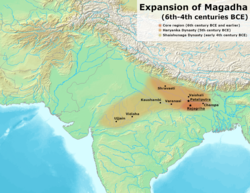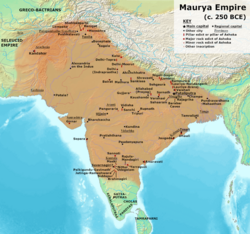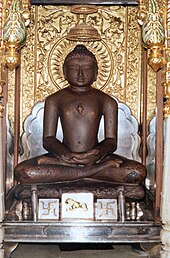For other uses, see Magadha (disambiguation).
| Kingdom of Magadha | |||||||||||||
|---|---|---|---|---|---|---|---|---|---|---|---|---|---|
| 1700 BCE – 550 CE | |||||||||||||
 Kingdom of Magadha and other Mahajanapadas during the second urbanization Kingdom of Magadha and other Mahajanapadas during the second urbanization | |||||||||||||
 Expansion and decline of Magadha-based rule Expansion and decline of Magadha-based rule between 6th and 2nd century BCE  Magadha-based rule under Haryanka and Magadha-based rule under Haryanka and Shaisunga dynasties  Magadha-based rule under Nanda dynasty Magadha-based rule under Nanda dynasty  Magadha-based rule under Maurya dynasty Magadha-based rule under Maurya dynasty  Magadha-based rule under Shunga dynasty Magadha-based rule under Shunga dynasty  Magadha-based rule under Kanva dynasty Territorial expansion of Magadha-based rulers 6th century BCE onwards Magadha-based rule under Kanva dynasty Territorial expansion of Magadha-based rulers 6th century BCE onwards | |||||||||||||
| Capital | Rajagriha (Girivraj) Later, Pataliputra (modern-day Patna) | ||||||||||||
| Common languages | Sanskrit Magadhi Prakrit Ardhamagadhi Prakrit | ||||||||||||
| Religion | Brahmanism Buddhism Jainism | ||||||||||||
| Demonym(s) | Māgadhī | ||||||||||||
| Magadha-based dynasties and empires | |||||||||||||
| • c. 544 – c. 413 BCE | Haryanka dynasty | ||||||||||||
| • c. 413 – c. 345 BCE | Shaishunaga dynasty | ||||||||||||
| • c. 345 – c. 322 BCE | Nanda dynasty | ||||||||||||
| • c. 322 – c. 185 BCE | Maurya Empire | ||||||||||||
| • c. 185 – c. 73 BCE | Shunga Empire | ||||||||||||
| • c. 73 – c. 28 BCE | Kanva dynasty | ||||||||||||
| • c. 1st cent. BCE – c. 2nd cent. BCE | Extraneous rule by Mitra dynasty (Kosambi) | ||||||||||||
| • c. 2nd – c. 3rd CE? | Extraneous rule by Mahameghavahana dynasty | ||||||||||||
| • c. 240 – c. 579 CE | Gupta Empire | ||||||||||||
| • c. 6th – c. 8th cent. CE | Later Guptas | ||||||||||||
| Historical era | Iron Age | ||||||||||||
| Currency | Panas | ||||||||||||
| |||||||||||||
| Today part of | |||||||||||||
Magadha was a region in ancient India, named after an ancient kingdom of the same name, which was one of the sixteen Mahajanapadas during the Second Urbanization period, based in the eastern Ganges Plain. The region was ruled by several dynasties, which overshadowed and incorporated the other Mahajanapadas. Magadha played an important role in the development of Jainism and Buddhism.
Geography
The territory of the Magadha kingdom proper before its expansion was bounded to the north, west, and east respectively by the Gaṅgā, Son, and Campā rivers, and the eastern spurs of the Vindhya mountains formed its southern border. The territory of the initial Magadha kingdom thus corresponded to the modern-day Patna and Gaya districts of the Indian state of Bihar.
The region of Greater Magadha also included neighbouring regions in the eastern Gangetic plains and had a distinct culture and belief.
History
Vedic period (semi-legendary) (ca. 1700 BCE-6th cent. BCE)
Main article: Vedic periodKikata kingdom

In the Atharvaveda the Maghadas are listed along with the Angas, Gandharis and Mujavats.
Some scholars have identified the Kīkaṭa tribe—mentioned in the Rigveda (3.53.14) with their ruler Pramaganda—as the forefathers of Magadhas because Kikata is used as synonym for Magadha in the later texts. Like the Magadhas in the Atharvaveda, the Rigveda speaks of the Kikatas as a hostile tribe, living on the borders of Brahmanical India, who did not perform Vedic rituals.
Brihadratha dynasty
Main article: Brihadratha dynastyAccording to the Puranas, the Brihadratha dynasty was the first ruling dynasty of Magadha.
Mahajanapada (6th-4th cent. BCE)
Second urbanisation
Much of the Second Urbanisation took place in Greater Magadha from c. 500 BCE onwards, and it was here that Jainism and Buddhism arose.
Haryanka dynasty (544 BCE–413 BCE)
Main article: Haryanka dynastyThere is little certain information available on the early rulers of Magadha. The most important sources are the Buddhist Pāli Canon, the Jain Agamas and the Hindu Puranas. The ancient kingdom of Magadha is also mentioned in the Ramayana, the Mahabharata. Based on Jain and Buddhist sources, it appears that Magadha was ruled by the Haryanka dynasty for some 130 years, c. 543 to 413 BCE.
The core of the kingdom was the area of Bihar south of the Ganges; its first capital was Rajagriha (modern day Rajgir), then Pataliputra (modern Patna). Rajagriha was initially known as 'Girivrijja' and later came to be known as so during the reign of Ajatashatru. Magadha expanded to include most of Bihar and Bengal with the conquest of Vajjika League and Anga, respectively.
Expansion (413 BCE-28 BCE)
Shaishunaga dynasty (413 BCE–345 BCE)

Nanda dynasty (c. 345 BCE–c. 322 BCE)
Main article: Nanda dynastyMaurya Empire (322 BCE – 185 BCE)
Main article: Maurya EmpireShunga Empire (185 BCE–73 BCE)
Main article: Shunga EmpireKanva dynasty (73 BCE–28 BCE)
Main article: Kanva dynastyExtraneous rule (28 BCE-c.240 CE)
Mitra dynasty (Kosambi) ( 1st cent. BCE - 2nd cent. CE)
Main article: Mitra dynasty (Kosambi)Mahameghavahana dynasty (2nd-3rd cent. CE?)
Main article: Mahameghavahana dynastyGupta's
Gupta Empire (c. 240–c. 579)
Main article: Gupta EmpireLater Guptas (c. 6th century CE–c. 8th century CE)
Main article: Later GuptasLater history
Main article: Pithipatis of Bodh GayaFrom the 11th century until the late 13th century, a group of Buddhist kings known as the Pithipatis ruled parts of the Magadha region. These kings referred to themselves as Magadhādipati which translates to "Lords of Magadha".
Buddhism and Jainism
Gautama Buddha, the founder of Buddhism, lived much of his life in the kingdom of Magadha. He attained enlightenment in Bodh Gaya, gave his first sermon in Sarnath and the first Buddhist council was held in Rajgriha.
Several Śramaṇic movements had existed before the 6th century BCE, and these influenced both the āstika and nāstika traditions of Indian philosophy. The Śramaṇa movement gave rise to diverse range of heterodox beliefs, ranging from accepting or denying the concept of soul, atomism, antinomian ethics, materialism, atheism, agnosticism, fatalism to free will, idealization of extreme asceticism to that of family life, strict ahimsa (non-violence) and vegetarianism to the permissibility of violence and meat-eating. Magadha kingdom was the nerve centre of this revolution.
Jainism was revived and re-established after Mahavira, the last and the 24th Tirthankara, who synthesised and revived the philosophies and promulgations of the ancient Śramaṇic traditions laid down by the first Jain tirthankara Rishabhanatha millions of years ago. Buddha founded Buddhism which received royal patronage in the kingdom.



According to Indologist Johannes Bronkhorst, the culture of Magadha was in fundamental ways different from the Vedic kingdoms of the Indo-Aryans. According to Bronkhorst, the śramana culture arose in "Greater Magadha," which was Indo-Aryan, but not Vedic. In this culture, Kshatriyas were placed higher than Brahmins, and it rejected Vedic authority and rituals. He argues for a cultural area termed "Greater Magadha", defined as roughly the geographical area in which the Buddha and Mahavira lived and taught.
With regard to the Buddha, this area stretched by and large from Śrāvastī, the capital of Kosala, in the north-west to Rājagṛha, the capital of Magadha, in the south-east". According to Bronkhorst, "there was indeed a culture of Greater Magadha which remained recognizably distinct from Vedic culture until the time of the grammarian Patañjali (ca. 150 BCE) and beyond". The Buddhologist Alexander Wynne writes that there is an "overwhelming amount of evidence" to suggest that this rival culture to the Vedic Aryans dominated the eastern Gangetic plain during the early Buddhist period. Orthodox Vedic Brahmins were, therefore, a minority in Magadha during this early period.
The Magadhan religions are termed the sramana traditions and include Jainism, Buddhism and Ājīvika. Buddhism and Jainism were the religions promoted by the early Magadhan kings, such as Srenika, Bimbisara and Ajatashatru, and the Nanda Dynasty (345–321 BCE) that followed was mostly Jain. These Sramana religions did not worship the Vedic deities, instead of practicing some form of asceticism and meditation (jhana) and tending to construct round burial mounds (called stupas in Buddhism). These religions also sought some type of liberation from the cyclic rounds of rebirth and karmic retribution through spiritual knowledge.
Language
Main article: Magadhi Prakrit See also: Ardhamagadhi PrakritBeginning in the Theravada commentaries, the Pali language has been identified with Magadhi, the language of the kingdom of Magadha, and this was taken to also be the language that the Buddha used during his life. In the 19th century, the British Orientalist Robert Caesar Childers argued that the true or geographical name of the Pali language was Magadhi Prakrit, and that because pāḷi means "line, row, series", the early Buddhists extended the meaning of the term to mean "a series of books", so pāḷibhāsā means "language of the texts". Nonetheless, Pali does retain some eastern features that have been referred to as Māgadhisms.
Magadhi Prakrit was one of the three dramatic prakrits to emerge following the decline of Sanskrit. It was spoken in Magadha and neighbouring regions and later evolved into modern eastern Indo-Aryan languages like Magahi, Maithili and Bhojpuri.
Historical figures from Magadha

Important people from the region of Magadha include:
- Śāriputra — born to a wealthy Brahmin in a village located near Rājagaha in Magadha. He is considered the first of the Buddha's two chief male disciples, together with Maudgalyāyana.
- Maudgalyāyana — born in the village of Kolita in Magadha. He was one of the Buddha's two main disciples. In his youth, he was a spiritual wanderer before meeting the Buddha.
- Mahavira — the 24th Tirthankara of Jainism. Born into a royal kshatriya family in what is now Vaishali district of Bihar. He abandoned all worldly possessions at the age of 30 and became an ascetic. He is considered a slightly older contemporary of the Buddha.
See also
- Greater Magadha
- History of India
- Magadha–Vajji war
- Magadha–Anga war
- Avanti–Magadhan War
- List of Indian monarchs
- Timeline of Indian history
- Magahi culture
- Magahi language
Notes
References
- Jain, Dhanesh (2007). "Sociolinguistics of the Indo-Aryan languages". In George Cardona; Dhanesh Jain (eds.). The Indo-Aryan Languages. Routledge. pp. 47–66, 51. ISBN 978-1-135-79711-9.
- Damien Keown (26 August 2004). A Dictionary of Buddhism. OUP Oxford. p. 163. ISBN 978-0-19-157917-2.
- Raychaudhuri, Hemchandra (1953). Political History of Ancient India: From the Accession of Parikshit to the Extinction of Gupta Dynasty. University of Calcutta. pp. 110–118.
- ^ Ramesh Chandra Majumdar (1977). Ancient India. Motilal Banarsidass Publ. ISBN 81-208-0436-8.
- Macdonell, Arthur Anthony; Keith, Arthur Berriedale (1995). Vedic Index of Names and Subjects. Motilal Banarsidass Publishers. ISBN 9788120813328.
- M. Witzel. "Rigvedic history: poets, chieftains, and polities," in The Indo-Aryans of Ancient South Asia: Language, Material Culture and Ethnicity. ed. G. Erdosy (Walter de Gruyer, 1995), p. 333
- Bronkhorst 2007, p.4: Bronkhorst "It is also in this area that a number of religious and spiritual movements arose, most famous among them Buddhism and Jainism.".
- Chandra, Jnan (1958). "Some Unknown Facts About Bimbisāra". Proceedings of the Indian History Congress. 21: 215–217. JSTOR 44145194.
- Ramesh Chandra Majumdar (1977). Ancient India. Motilal Banarsidass Publ. ISBN 81-208-0436-8.
- Schwartzberg, Joseph E. (1978). A Historical Atlas of South Asia. Chicago: University of Chicago Press. p. 145, map XIV.1 (a). ISBN 0226742210.
- Sircar, D. C. (1978). "Bodhgayā Inscription of Pithipati Ācārya Buddhasena". Senarat Paranavitana Commemoration Volume: 255–256. doi:10.1163/9789004646476_033. ISBN 978-90-04-64647-6.
- "Lumbini Development Trust: Restoring the Lumbini Garden". Archived from the original on 6 March 2014. Retrieved 6 January 2017.
- Ray, Reginald (1999). Buddhist Saints in India. Oxford University Press. pp. 237–240, 247–249. ISBN 978-0195134834.
- Jaini, Padmanabh S. (2001). Collected papers on Buddhist Studies. Motilal Banarsidass. pp. 57–77. ISBN 978-8120817760.
- Patel, Haresh (2009). Thoughts from the Cosmic Field in the Life of a Thinking Insect [A Latter-Day Saint]. Strategic Book Publishing. p. 271. ISBN 978-1-60693-846-1.
- "Auction 396. INDIA, Mauryan Empire , Karshapana (14mm, 3.32 g). circa 315-310 BC". www.cngcoins.com. Retrieved 24 April 2024.
- ^ Bronkhorst 2007, p. .
- Long, Jeffery D. (2009). Jainism : an introduction. London: I.B. Tauris. ISBN 978-1-4416-3839-7. OCLC 608555139.
- Witzel, Michael (1997). "Macrocosm, Mesocosm, and Microcosm: The Persistent Nature of 'Hindu' Beliefs and Symbolic Forms". International Journal of Hindu Studies. 1 (3): 501–539. doi:10.1007/s11407-997-0021-x. JSTOR 20106493. S2CID 144673508.
- Bronkhorst 2007, pp. xi, 4.
- ^ Bronkhorst 2007, p. 265.
- Wynne, Alexander (2011). "Review of Bronkhorst, Johannes, Greater Magadha: Studies in the Culture of Early India". H-Buddhism. Retrieved 25 August 2019.
- A Dictionary of the Pali Language By Robert Cæsar Childers
- Rupert Gethin (9 October 2008). Sayings of the Buddha: New Translations from the Pali Nikayas. OUP Oxford. pp. xxiv. ISBN 978-0-19-283925-1.
- Beames, John (2012). Comparative Grammar of the Modern Aryan Languages of India: To Wit, Hindi, Panjabi, Sindhi, Gujarati, Marathi, Oriya, and Bangali. Cambridge: Cambridge University Press. doi:10.1017/cbo9781139208871.003. ISBN 978-1-139-20887-1.
- Prasad, Chandra Shekhar (1988). "Nalanda vis-à-vis the Birthplace of Śāriputra". East and West. 38 (1/4): 175–188. JSTOR 29756860.
- Gunapala Piyasena Malalasekera (2007). Dictionary of Pāli Proper Names. Motilal Banarsidass Publishers. pp. 403–404. ISBN 978-81-208-3022-6.
- Romesh Chunder Dutt (5 November 2013). A History of Civilisation in Ancient India: Based on Sanscrit Literature: Volume I. Routledge. pp. 382–383. ISBN 978-1-136-38189-8.
Sources
- Raychaudhuri, H.C. (1972). Political History of Ancient India. Calcutta: University of Calcutta.
- Law, Bimala Churn (1926). "4. The Magadhas". Ancient Indian Tribes. Lahore: Motilal Banarsidas.
- Bronkhorst, Johannes (2007). Greater Magadha: studies in the culture of early India (PDF). Handbook of oriental studies. Section two, India. Vol. 19. Leiden; Boston: Brill. ISBN 978-90-04-15719-4. ISSN 0169-9377. OCLC 608455986. Archived from the original (PDF) on 11 September 2015.
- Singh, Upinder (2016), A History of Ancient and Early Medieval India: From the Stone Age to the 12th Century, Pearson, ISBN 978-81-317-1677-9
| Mahajanapadas | |
|---|---|
| Great Indian Kingdoms (c. 600 BCE–c. 300 BCE) | |
| Middle kingdoms of India | |||||||||||||||||||||||||||||||||||||||||||||||||||||||||||||||||||||||||||||||||||||||||||||||||||||||||||||||||||||||||||||||||||||||||||||||||||||||||||||||||||||||||||||
|---|---|---|---|---|---|---|---|---|---|---|---|---|---|---|---|---|---|---|---|---|---|---|---|---|---|---|---|---|---|---|---|---|---|---|---|---|---|---|---|---|---|---|---|---|---|---|---|---|---|---|---|---|---|---|---|---|---|---|---|---|---|---|---|---|---|---|---|---|---|---|---|---|---|---|---|---|---|---|---|---|---|---|---|---|---|---|---|---|---|---|---|---|---|---|---|---|---|---|---|---|---|---|---|---|---|---|---|---|---|---|---|---|---|---|---|---|---|---|---|---|---|---|---|---|---|---|---|---|---|---|---|---|---|---|---|---|---|---|---|---|---|---|---|---|---|---|---|---|---|---|---|---|---|---|---|---|---|---|---|---|---|---|---|---|---|---|---|---|---|---|---|---|---|
| |||||||||||||||||||||||||||||||||||||||||||||||||||||||||||||||||||||||||||||||||||||||||||||||||||||||||||||||||||||||||||||||||||||||||||||||||||||||||||||||||||||||||||||
| Magadh division topics | |
|---|---|
| General | |
| Districts | |
| Community development blocks | |
| Rivers | |
| Transport | |
| Railway stations | |
| Lok Sabha constituencies | |
| See also | |
| Other divisions | |
| Historical regions of North India | |
|---|---|
- Magadha
- 6th-century disestablishments in India
- Buddhist dynasties of India
- Former kingdoms
- Former monarchies of India
- Hindu dynasties
- Historical Indian regions
- History of Bengal
- History of Bihar
- History of Jharkhand
- History of Odisha
- Iron Age cultures of South Asia
- Jain empires and kingdoms
- Kingdoms in the Mahabharata
- Kingdoms of Bihar
- Magahi language
- Mahajanapadas
- Regions of Bihar
- Regions of Jharkhand
- Regions of Odisha
- States and territories established in the 17th century BC
- States and territories disestablished in the 6th century